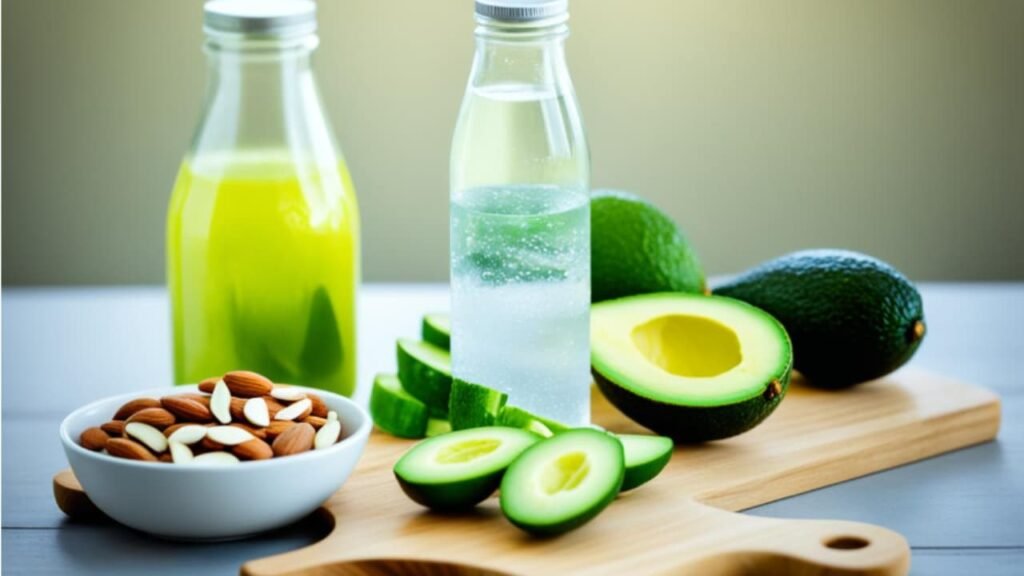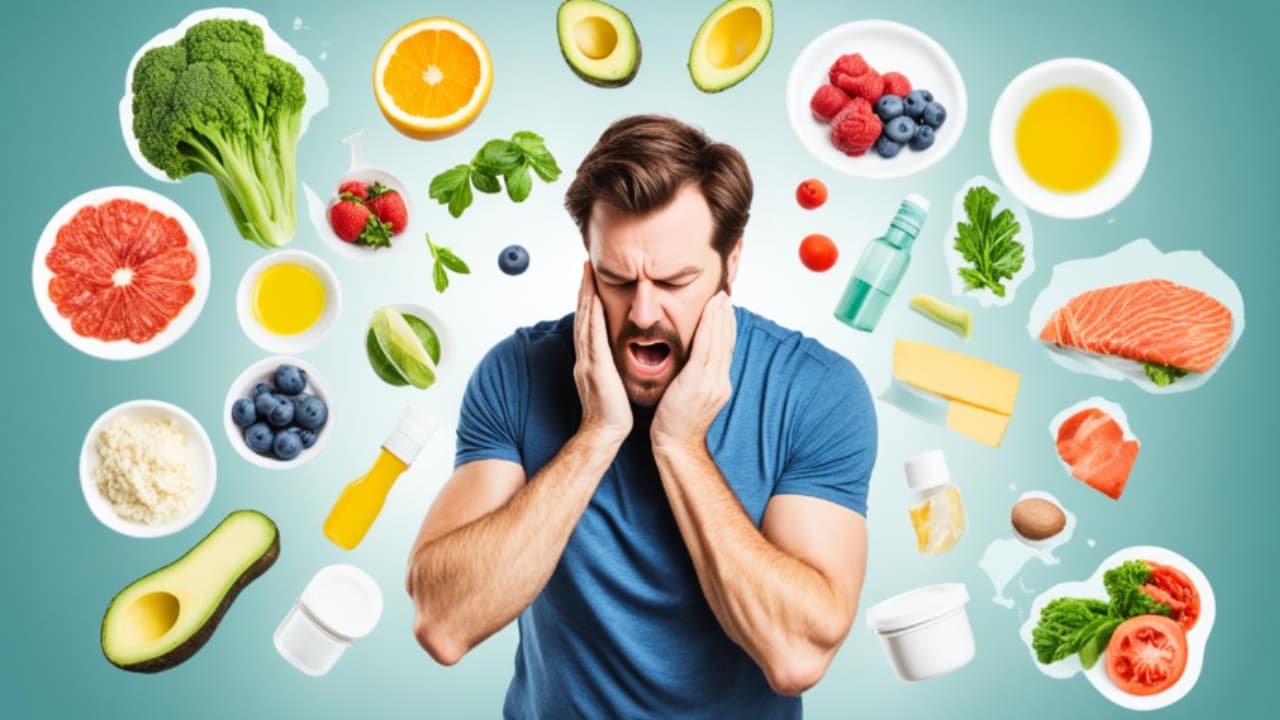Table of Contents
ToggleAre you thinking about starting a ketogenic diet but worry about the “keto flu”? You’re not the only one. Many people on this low-carb path face symptoms like headaches, fatigue, muscle cramps, and digestive problems. But don’t worry, you can beat the keto flu and move into fat-burning ketosis with the right strategies.
Key Takeaways
- Keto flu symptoms can range from mild to severe and typically last a few days to several weeks
- Dehydration, electrolyte imbalances, and carb withdrawal are common causes of the keto flu
- Staying hydrated, replenishing electrolytes, and getting adequate rest can help manage keto flu symptoms
- A gradual transition to a ketogenic diet may help reduce the severity of the keto flu
- Certain individuals, such as those with underlying health conditions, may need to avoid keto diets altogether
What is the Keto Flu?
The keto flu is a set of symptoms some people feel when starting the ketogenic diet. This diet cuts down on carbs, aiming for less than 50 grams a day. That’s much less than the usual 200-300 grams in a balanced diet. As the body switches from using glucose to ketones for energy, it can cause flu-like symptoms.
Symptoms of the Keto Flu
The keto flu brings on symptoms like:
- Fatigue
- Brain fog
- Nausea
- Constipation
- Headaches
- Muscle cramps
- Dizziness
- Irritability
- Difficulty sleeping
- Food cravings
These symptoms usually get worse in the first few days and can last from a few days to weeks. This is while the body gets used to the new diet.
| Statistic | Value |
|---|---|
| Carb intake on the keto diet | Fewer than 50 grams per day |
| Duration of keto flu symptoms | A few days to a few weeks |
| Peak of keto flu symptoms | Days 1-4 of starting the diet |
| Threshold for nutritional ketosis | Blood concentration of 0.5 mmol/L or more of beta-hydroxybutyrate |
Switching to a ketogenic diet can be tough. The body must learn to use ketones instead of glucose for energy. This change can lead to a bunch of not-so-pleasant side effects, known as the keto flu. Knowing about the symptoms and reasons behind the keto flu can help people get ready for and handle this tough time.
Causes of the Keto Flu
Switching to a ketogenic diet can cause symptoms like the “keto flu.” This happens when the body starts using fat for fuel instead of glucose. The keto flu is caused by changes in electrolyte levels, dehydration, and not getting enough carbs.
When you eat fewer than 50 grams of carbs a day, you enter ketosis. This process can make you feel like you have the flu, affecting up to 65% of kids with epilepsy on this diet. The diet might also lead to not getting enough vitamins and minerals like calcium and vitamin D.
Switching to fat for energy can upset the balance of electrolytes in your body. This can cause dehydration and other bad side effects. A study found that adults with type 1 diabetes on a keto diet had almost one low blood sugar event a day. This shows how important it is to keep electrolyte levels right.
Also, not eating as many carbs can make you feel like you’re going through withdrawal. Your body is used to running on glucose. This can add to the discomfort of the keto flu.
Knowing why the keto flu happens is key to getting through it easier. By managing electrolyte levels, staying hydrated, and dealing with carb withdrawal, you can make the start of a ketogenic diet smoother. This helps you reach your health goals.

“A long-term observational study linked animal-based low-carb diets to higher rates of death from heart disease, cancer, and all causes, while vegetable-based low-carb diets were associated with a lower rate of death from heart disease and all causes.”
The keto flu can be tough, but with the right knowledge and care, you can get past it. This way, you can enjoy the benefits of a ketogenic diet.
Managing the Keto Flu
Switching to a ketogenic diet can cause symptoms like the “keto flu.” But, there are ways to make these symptoms less severe. These methods help your body adjust to using fat for energy.
Stay Hydrated
Drinking enough water is key when you’re feeling the keto flu. This diet can lead to losing water and electrolytes, causing tiredness, headaches, and muscle cramps. Drink lots of water to keep your body hydrated and support it.
Replace Electrolytes
Electrolytes like sodium, potassium, and magnesium are important to replace during the keto flu. Eat foods high in these minerals, like avocados, nuts, seeds, and leafy greens. Or, use electrolyte drinks or salt solutions to help balance your body.
Get Adequate Sleep
Getting enough sleep is vital for beating the keto flu. Not sleeping well can make symptoms like brain fog, irritability, and tiredness worse. Try to sleep 7-8 hours each night to help your body adjust to the new diet.
Gradual Carb Reduction
Some people find it easier to cut carbs slowly rather than suddenly. Reducing carbs over time can make the transition smoother and lessen keto flu symptoms.
By drinking plenty of water, replacing electrolytes, sleeping well, and cutting carbs slowly, you can make the keto flu easier to handle. This helps you smoothly move into a ketogenic lifestyle.
Combating the Keto Flu
Switching to a ketogenic diet can lead to the “keto flu.” This means feeling tired, having headaches, and muscle cramps. But, there are ways to ease these symptoms and make the change easier.
Stay Hydrated
Dehydration is a big reason for the keto flu. The diet can make you lose water and electrolytes, causing bad feelings. To fight this, drink lots of water all day. Try to drink at least half your body weight in ounces of water to stay hydrated.
Replace Electrolytes
It’s also key to replace electrolytes like sodium, potassium, and magnesium. These are important for your muscles and nerves to work right. Without enough, you might feel muscle cramps, get tired, or feel sick. Eat foods high in electrolytes like avocados, spinach, and nuts, or think about taking an electrolyte supplement.
Get Adequate Sleep
Good sleep is crucial, especially when starting a new diet. Getting enough sleep helps your body handle the keto diet better and can lessen symptoms like feeling grumpy or foggy. Try to sleep 7-9 hours a night. Use relaxation methods like meditation or yoga to help you sleep well.
By drinking water, getting electrolytes, and sleeping well, you can beat the keto flu. Remember, this phase is short, and with the right steps, you’ll feel great soon. The keto diet can be a big change, but it’s worth it for the benefits of ketosis.

Who Should Avoid Keto Diets?
The ketogenic diet focuses on lots of fat, moderate protein, and very few carbs. It’s not good for everyone. Some people should not follow this diet because it could be harmful or make health problems worse.
Pregnant women and those breastfeeding should not try the keto diet. It might not give the right nutrients to the baby or the nursing baby. Kids and teens should also not do the keto diet without a doctor’s watchful eye. Their bodies need different nutrients as they grow.
People with kidney, liver, or pancreatic issues should not do the keto diet. It could make these organs work harder. Those with diabetes should talk to their doctor before starting the keto diet. It can change blood sugar levels and affect the medicines they take.
Also, if you’re very sensitive to dietary cholesterol, you might want to think twice about the keto diet. It has a lot of fat and cholesterol.
| Population | Keto Diet Recommendation |
|---|---|
| Pregnant or breastfeeding women | Avoid |
| Children and teenagers | Avoid, unless under medical supervision |
| Individuals with kidney disease, liver disease, or pancreatic conditions | Avoid |
| People with diabetes | Consult a healthcare provider |
| Those with cholesterol sensitivity | Reconsider |
It’s crucial to think about your own health before starting the keto diet. Always talk to a healthcare professional to see if it’s right for you.

Conclusion
The keto flu, or carb flu, is a real issue for some when they start a ketogenic diet. Symptoms like fatigue, headaches, nausea, constipation, and muscle cramps happen as the body adjusts to using fat for fuel instead of carbs. To ease the transition, it’s important to drink plenty of water, replace electrolytes, and get enough sleep.
Not everyone can do the ketogenic diet, like pregnant women, kids, and people with certain health issues. Knowing the challenges and how to handle them can help those on a low-carb diet get through the tough times. Drinking water, replacing electrolytes, and resting can lessen the keto flu symptoms. It’s wise to talk to a doctor or a dietitian, especially if you have health concerns or special dietary needs.
The keto flu is just a short-term issue, and with the right steps, most people feel better in a week. Being informed and ready can help you beat the keto flu and enjoy the benefits of a well-planned ketogenic diet.
Read more abou: Keto Diet for Diabetics: My Journey to Better Blood Sugar Control
FAQ
What is the keto flu?
The “keto flu” or “carb flu” is a set of symptoms some people get when starting a ketogenic diet. This diet is very low in carbs but high in fat and protein. The sudden change in diet can cause symptoms like fatigue, headaches, nausea, and constipation.
These symptoms happen as the body adjusts to burning fat for energy instead of carbs.
What are the symptoms of the keto flu?
Common keto flu symptoms include nausea, vomiting, constipation, diarrhea, headache, irritability, weakness, muscle cramps, dizziness, brain fog, stomach or intestinal pain, muscle soreness, difficulty sleeping, and food cravings.
What causes the keto flu?
The keto flu is caused by the body’s adaptation to a high-fat, very low-carb diet. Factors like electrolyte loss, dehydration, and carbohydrate withdrawal can contribute to the symptoms.
How can I manage the keto flu?
To reduce keto flu symptoms, stay hydrated, replace lost electrolytes, get adequate sleep, and consider gradually reducing carbs rather than eliminating them all at once.
How can I combat the keto flu?
To combat the keto flu, stay hydrated by drinking plenty of water, replace electrolytes like sodium, potassium, and magnesium, get enough sleep, and consider light exercise like yoga or walking.
Who should avoid keto diets?
Keto diets should be avoided by pregnant or breastfeeding women, children, teens, and those with certain health conditions like kidney disease, liver disease, pancreatic conditions, or diabetes. They may also not be suitable for those who are hypersensitive to dietary cholesterol.





